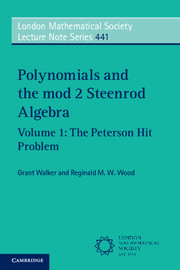Book contents
- Frontmatter
- Contents of Volume 1
- Contents of Volume 2
- Preface
- 1 Steenrod squares and the hit problem
- 2 Conjugate Steenrod squares
- 3 The Steenrod algebra A2
- 4 Products and conjugation in A2
- 5 Combinatorial structures
- 6 The cohit module Q(n)
- 7 Bounds for dim Qd(n)
- 8 Special blocks and a basis for Q(3)
- 9 The dual of the hit problem
- 10 K(3) and Q(3) as F2GL(3)-modules
- 11 The dual of the Steenrod algebra
- 12 Further structure of A2
- 13 Stripping and nilpotence in A2
- 14 The 2-dominance theorem
- 15 Invariants and the hit problem
- Bibliography
- Index of Notation for Volume 1
- Index for Volume 1
- Index of Notation for Volume 2
- Index for Volume 2
7 - Bounds for dim Qd(n)
Published online by Cambridge University Press: 06 November 2017
- Frontmatter
- Contents of Volume 1
- Contents of Volume 2
- Preface
- 1 Steenrod squares and the hit problem
- 2 Conjugate Steenrod squares
- 3 The Steenrod algebra A2
- 4 Products and conjugation in A2
- 5 Combinatorial structures
- 6 The cohit module Q(n)
- 7 Bounds for dim Qd(n)
- 8 Special blocks and a basis for Q(3)
- 9 The dual of the hit problem
- 10 K(3) and Q(3) as F2GL(3)-modules
- 11 The dual of the Steenrod algebra
- 12 Further structure of A2
- 13 Stripping and nilpotence in A2
- 14 The 2-dominance theorem
- 15 Invariants and the hit problem
- Bibliography
- Index of Notation for Volume 1
- Index for Volume 1
- Index of Notation for Volume 2
- Index for Volume 2
Summary
Introduction
The dimension of the vector space Pd(n) increases with d for a fixed n. By contrast, we show in Section 7.1 that there is an upper bound for dim Qd(n) which is independent of d. The proof involves the idea of an α +-bounded monomial. These span Qd(n), and in a given degree d the number of α +-bounded monomials is bounded by a function of n. However, for n > 2, the bound is too large to be of practical use.
In Section 7.2, the 1-back splicing technique introduced in Section 6.4 is extended to multiple 1-back splicing, and is used to show that Qω(n) = 0 if ω>l ωmax(n,d), the maximum element of Decd(n) (compare Theorem 6.3.12). In the case where Decd(n) has only one element ω, we use the same technique to show that any block in Pd(n) with ω-sequence right lower than ωmin(d) is hit. In Chapter 14, this will be proved for every degree d.
In Section 7.3, we introduce semi-standard monomials and blocks. Under certain conditions on ω, Qω(n) is spanned by semi-standard blocks. In contrast to α+-bounded monomials, when n ≥ 2 the number of semi-standard monomials in a given degree is not bounded. Multiple 1-back splicing involves the interchange of entries between adjacent columns of a block, together with certain ‘error’ terms when applied to the action of the Steenrod algebra. By ignoring the error terms, we obtain the notion of combinatorial splicing. Using iterated combinatorial splicing, a block with decreasing ω-sequence is equivalent to a sum of semi-standard blocks.
In Section 7.4 we show how various notions in the previous section translate into the combinatorial theory of Young tableaux. The hook-length formula (7.1) gives the number of semi-standard blocks. In the case d = 2n −n−1 we show that the semi-standard blocks form a basis of Qd(n) and that dim Qd(n)= 2n(n−1)/2. In this case we show in Chapter 22 that Qd(n) is the Steinberg representation St(n) of GL(n). For an arbitrary decreasing sequence ω of 2-degree d, we show in Proposition 7.4.5 that an ordering on Decd(n) can be chosen, dependent on ω, for which Qω(n), defined using this order, is spanned by semi-standard monomials.
- Type
- Chapter
- Information
- Polynomials and the mod 2 Steenrod Algebra , pp. 123 - 138Publisher: Cambridge University PressPrint publication year: 2017

